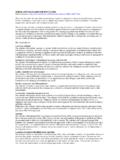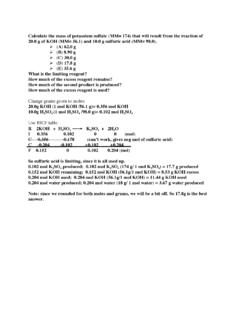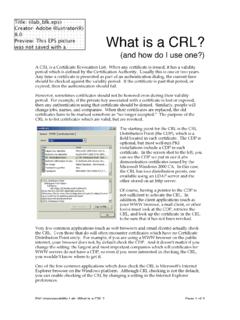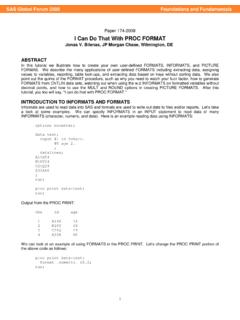Transcription of Hand-held Doppler Ultrasound: The assessment of …
1 Table 1: Explain the procedure and reassure the patient and ensure that he/she is lying flat and is comfortable, relaxed and adequately rested with no pressure on the proximal vesselsKey WordsDoppler ultrasound , assessment , ABPI, Leg ulcer management, Varicose veinsHand- held Doppler Ultrasound: The assessment of lower limb arterial and venous diseaseKathryn Vowden BSc(Hons) RN DPSN(TV) Clinical Nurse Specialist, Department of Vascular Surgery, Bradford Royal Infirmary and Lecturer, University of BradfordPeter Vowden MD FRCS Consultant Vascular Surgeon, Bradford Royal Healthcare 200211.
2 Measure the brachial systolic blood pressure: Place an appropriately sized cuff around the upper arm Ensure that the equipment and the arm are at heart level Locate the brachial pulse and apply ultrasound contact gel Angle the Doppler probe at 45oand move the probe to obtain the best signal Inflate the cuff until the signal is abolished then deflate the cuff slowly and record the pressure at which the signal returns being careful not to move the probe from the line of the artery Repeat the procedure for the other arm Use the highest of the two
3 Values as the best non-invasive estimate of central systolic pressure and use this figure to calculate the ABPI2. Measure the ankle systolic pressure: Place an appropriately sized cuff around the ankle immediately above the malleoli having first protected any ulcer or fragile skin that may be present (Figure 1) Examine the foot, locating the dorsalis pedis pulse (Figure 2) and apply contact gel Continue as for the brachial pressure, recording this pressure in the same way again with equipment at heart level Repeat this for the posterior tibial and if required the peroneal and anterior tibial arteries Use the highest reading obtained to calculate the ABPI for that leg Repeat for the other leg Calculate the ABPI for each leg using the formula below or look up the ABPI using a reference chartABPI = Highest pressure recorded at the ankle for that leg Highest brachial pressure obtained for both armsABPI normally > < indicates arterial disease
4 ABPI > and < can be associated with claudication and if symptoms warrant a patient should be referred for further assessmentABPI < indicates severe arterial disease and may be associated with gangrene, ischaemic ulceration or rest pain and warrants urgent referral for a vascular opinionFigure arteries of the foot demonstrating the siteof probe application for the PT, AT and ultrasound is frequently usedas a screening tool when assessingpatients for arterial disease. The ankle brachial pressure index(ABPI) is derived from the highest ofthe two arm systolic pressures, takenas the best non-invasive estimate ofcentral systolic pressure, and thehighest ankle systolic pressure foreach limb and can indicate both thepresence and severity of arterialdisease.
5 The use of this equipmentand ABPI calculation is now considered mandatory in leg ulcer management and is used routinely invascular assessment . An ABPI of higher is taken to indicate that, ifappropriate, a limb is suitable for highcompression bandaging. A procedure maximising the accuracyof Doppler ABPI has been recognisedfor some time and has been restatedby Vowden et al (1996a) (Table 1) and this, along with similar descrip-tions (Stubbing et al, 1997), nowrepresents a standard for thisinvestigation in nursing practice. Doppler and ABPIThe origins of the ABPI are in themedical literature but the Dopplerprinciple is based in physics and canbe applied to any energy venous ulcer protected to allowapplication of sphygmomanometer cuff atankle, Doppler probe positioned over DorsalisPedis 18/6/04 11:41 Page 3 Kathryn Vowden, Peter VowdenHand- held Doppler ultrasound .
6 The assessment of lower arterial and venous diseaseChristian Doppler and the Doppler principleChristian Doppler (1803-1853) was anAustrian professor in ElementaryMathematics and Practical Geometryat the Institute of Physics at ViennaUniversity. A biography describes himas a genius (O'Connor et al, 1998). Professor Dopplerfirst presented hiswork, entitled "Onthe coloured light of the double starsand certain otherstars of theheavens", in Prague on the 25th May1842. The principle he described,now regarded as the Doppler principlewas first published a year later( Doppler , 1843) and relates thefrequency of a source to its velocityrelative to an observer.
7 This principlewas initially not accepted but in 1846 Doppler published the theory again(cited in O'Connor et al., 1998)considering, on this occasion, both themotion of the source and the motionof the observer. At the same time heperformed experiments with soundusing musicians on a moving train toillustrate his theory. Although his theorywas finally accepted equipment wasnot then available to completelyvalidate it. The most common exampleof the Doppler principle is a movingsiren or train where the frequency ofthe sound changes as the sourceapproaches (Figure 4).
8 Other applications include a policespeed trap!As the sound source approaches the frequency increases,as the source moves away the frequency decreasesDoppler principle inmedicineThe first application of the Dopplereffect in medicine was made bySatomura in 1957 (cited in Yao, 1970a)who used it to study heart structureand function publishing this work in1959 (Satomura, 1959). This principlewas then extended to examine bloodflow in peripheral arteries. Satomuraand Kaneko (1960) (cited in Yao,1970a) giving the first description of anon invasive method of studying bloodflow in peripheral arteries in (1961) produced an ultrasonicflow meter based on the Dopplereffect from which the nowcommercially available portablecontinuous wave Doppler wasdeveloped.
9 Strandness et al (1967;1969) and Sigel et al (1968) used thisequipment in patients with peripheralarterial and venous disease,establishing the method of assessmentand the pitfalls of the technique. ABPI and arterial diseaseHamilton et al (1936; cited in Hocken,1967) established the link betweendirect and cuff measurement of bloodpressure and Winsor (1950) noted thedifference between arm and anklepressures. Prior to the early 1960's itwas not routine to measure the bloodpressure in the lower limb (Hocken,1967). Hocken (1966;1967), using astethoscope and Korotcow sounds,established that it was feasible tomeasure the blood pressure in the footbut concluded that this was not asatisfactory method for routinepractice as the arteries at the ankle donot lend themselves to this technique(Yao, 1993).
10 In these papers Hockenwas able to demonstrate an arm legpressure gradient with leg pressuresusually being 20mmHg higher than the year later Yao et al (1968)reported using ultrasound and the Doppler effect as a new method ofrecording arterial flow using both theflow velocity patterns and audiblesound. In this study they comparedthe accuracy of Doppler with pulsepalpation noting that in 136 legs inwhich the pulse could not be palpated,only 14 failed to show a Dopplersignal. Yao et al (1969) alsodemonstrated that Doppler is a reliableand simple method of measuring anklesystolic pressure stating that it shouldbe common practice but commentsthat it was, at that time, not.





